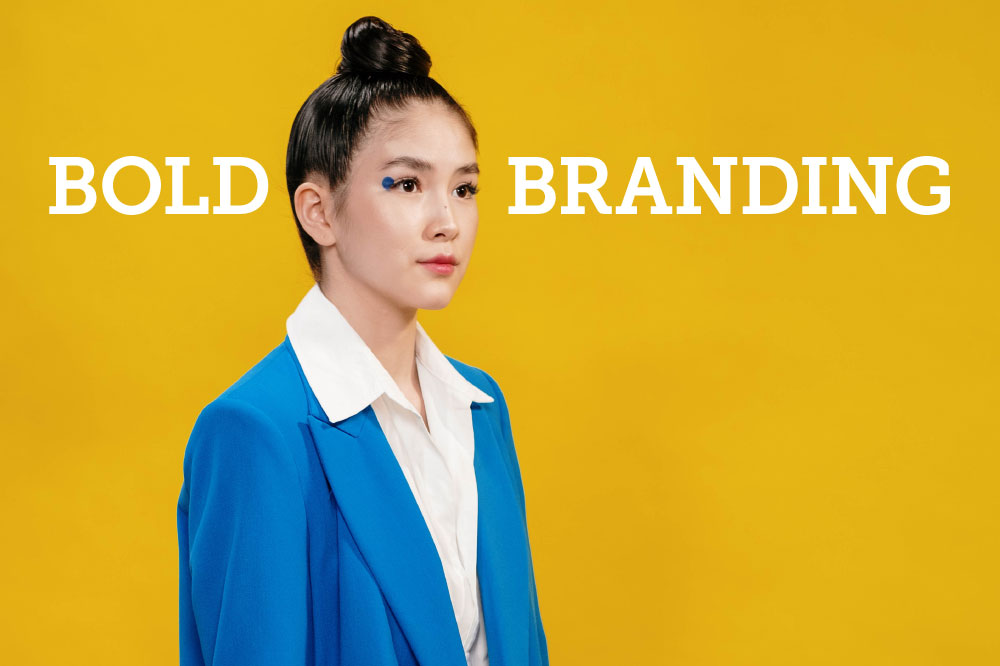
First, let’s define “bold” branding.
Bold branding is the strategic creation of a strong, distinct and memorable identity that stands out from competitors. The idea behind bold branding is to get noticed, forge an emotional connection with consumers, and ultimately drive sales. Think about it: if you went to a party or networking event and met identical twins, and one was dressed in a unique electric blue blazer discussing topics you’d never before heard, while the other was dressed similarly to everyone else and made polite small talk, you would be unable to forget the first twin, and most likely forget the second. And before you reply “clothes don’t make the person”, remember that 55% of first impressions are visual.
Bold doesn’t (necessarily) mean bright colors and heavy sans serif typefaces.
It might be a pastel in an industry dominated by reds. It could be a serif typeface in a world of blocky sans serif tech logos. Maybe it’s a website that’s entirely greyscale. It could be eschewing photography and illustration altogether for a type forward design that puts all the attention on the messaging. That said, the bold path should be backed by strategy rather than rebelling without a cause.
Bold branding is actually the act of making brave choices.
If it makes you a little nervous but it feels honest and on point, you’re going in the right direction. Bold brands will not be for everyone – and that is where the magic lies. Bold brands speak loudly to the right audience, holding their attention longer and securing long term loyalty. Keep in mind that surprising colors and typeface choices are not enough to build a strong brand. Bold brands also need a solid foundation, rooted in strategy, in order to support and execute the several brave choices they will make along the way. At Four Fin, we work with brands that have a purpose—and it’s an extra treat when those brands also choose to be purposefully bold!
Why is color so important?
That’s like asking why the sky is blue. In other words, there’s a scientific answer! A brand’s color is often more memorable than its name. As a matter of fact, a Loyola study revealed “Color increases brand recognition by 80%”. Not sure what colors you should use? That’s where we come in. Hint: it probably has nothing to do with your personal favorite color (sorry).
Color isn’t everything though, right?
Of course not. Typography, photography, patterns, layout, tone of voice and the logo (notice we didn’t mention this first?) all combine with color to create a cohesive visual experience. While these brand elements are being defined, thought needs to be given to flexibility, extendibility, and consistency, without redundancy. If it sounds like a lot to get right, that’s because it is. However, it doesn’t have to be heavy. Make it light and have some fun, by hiring a trusted professional to work on your brand. Collaboration and trust are where the magic happens.
OK, but how does this translate to higher earnings?
Bold brands stand out, and not just to the consumer. We have seen how strong brands also generate significantly higher shareholder returns. According to the report “Why Brands Matter 2022: New Evidence from the UK,” which analyzed data from both S&P and the Financial Times Stock Exchange 100 benchmarks, the top 50 brands in the UK generated returns that were 30% higher than the FTSE 100 benchmarks.
McKinsey & Company found that the top industrial brands captured the vast majority of public attention. Additionally companies that raised their visibility significantly were rewarded. They recommend launching bold marketing campaigns to generate interest, and point out that some companies are achieving this by borrowing from B2C best practices. This research also shows that for most brands, visibility declines over time. Knowing this, being bold in the space you have, when you have it, is also smart business.
Revecka Jallad of Forbes points out that investing in a brand and making brand awareness a top priority is critical. He points out that the traditional sales funnel is no longer a reliable model, and that if the goal is to grow conversions, then brand awareness is the best route.
TL;DR
When it comes to building a strong brand that will sustain both business and its higher purpose, it is more of a risk for that brand to not be bold. View some of our bold brands here!







